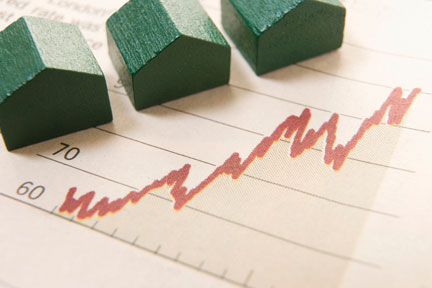
The New Normal
 Even though they cross their fingers when they say it, economists and industry experts predict the 2014 homebuilding market to continue to improve for both buyers and sellers, steadily climbing back to “normal” after years of distress.
Even though they cross their fingers when they say it, economists and industry experts predict the 2014 homebuilding market to continue to improve for both buyers and sellers, steadily climbing back to “normal” after years of distress.
Or maybe we should say a “new normal,” meaning steady, sustained growth instead of the “boom and bust” cycle that has marked so much of the decade.
In fact, by the end of 2013, home sales had slowed as interest rates rose and home prices rose even faster. Exacerbating factors included the government shutdown, which inspired economic angst among buyers.
The good news for buyers is that the slowdown in demand for homes at the end of 2013 dampened talk of another bubble forming and loosened up the supply, which had gotten tight.Still, economists forecast the new-home market would continue to lead the economic recovery in 2014. The reasons:
• The unemployment rate is expected to continue its slow improvement. People need jobs — and to feel secure about the jobs they have — to buy homes. At presstime, the national unemployment rate had dropped to 7 percent and the Florida unemployment rate had dropped to 6.4 percent.
• Mortgage interest rates, which are continuing to tick up, should remain near historically low averages. The Mortgage Bankers Association predicts that interest rates for a 30-year, fixed-rate mortgage are likely to creep past the current 3.8 percent to 5 percent in 2014. That’s considerably higher, but nowhere near pre-crash numbers.
Economists at Goldman Sachs have analyzed the potential impact of rising rates and have come up with some intriguing outcomes. The bottom line is, absent any other mitigating factors, it shouldn’t matter much.
The Goldman economists, Hui Shan and Marty Young, started their analysis based on home affordability. Take the median household income in the United States ($50,000), assume a buyer has a 20 percent down payment and that they can only afford debt payments equal to 25 percent of their income.
At a 30-year, fixed-rate mortgage rate of about 3.8 percent, the typical American homebuyer can afford a home with a $279,000 price tag. That’s 45 percent higher than the median nationwide price is now.
The Goldman study infers that slight increases in mortgage rates shouldn’t deter buyers, particularly if rates are rising based on an improving overall economy. In other words, the fact that mortgage rates are rising is less important than why they are rising.
Indeed, regardless of rates, stronger economic growth makes homebuying more appealing. Goldman estimates that a 1 point rise in real GDP growth translates to 1.8 percentage points in annual home price appreciation.
And the third quarter of 2013 — the last full quarter for which we have information — notched a surprising 4.1 percent growth rate, the highest in five years. Even the most bul-lish economists were taken aback by the unexpectedly strong number.
Higher inflation can also make homebuying more desirable. That means the asset you’re buying at a fixed interest rate should appreciate, which is a welcome change from the value declines experienced during the depths of the crash.
All that being the case, as long as home prices remain below the level where affordability is out of reach, and as long as mortgage rates are rising because the economy is on the mend, the housing market should be able to continue its growth.
So it shouldn’t be surprising that surveys show the number of people planning to buy a home in the next six months is soaring, according to National Association of Home Builders’ economist David Crowe. That means, Crowe says, that fence-sitters who’d been waiting for the bottom of the market now realize that the bottom has come and gone.
The real potential damper on new-home sales is the fact that mortgages are still difficult for many to get and developable land in places where people want to live is pricey and in short supply.
Still, nationally, the new-home market is expected to continue climbing back to a healthy and sustainable 1.3 million starts a year, says Crowe.
Starts climbed from a trough of 353,000 in 2009 to 629,000 at the end of 2013. Crowe is predicting a 31 percent increase to 826,000 in 2014 and another 41 percent in 2015 to 1.16 million, closing in on a more typical rate in the low seven figures.
The rising tide of home sales doesn’t lift every buyer, says John Burns, CEO of John Burns Real Estate Consulting, which provides advice to the real estate and the homebuilding industries, Because of stricter lending requirements, first-time buyers have been a smaller part of the resurging market, he says.
More affluent move-up buyers are a larger share of the market now than is typical. Foreign buyers in a number of destination markets, including Orlando but not so much in Jacksonville, also represent a historically disproportionate share of the improving market.

Renters, now paying more in rent than they would in mortgages and property taxes, are also likely to jump into the home market if they can find loans, Burns notes.
Meanwhile, first-time buyers with no credit track records or poor credit will continue to have difficulty joining the party until they can meet stricter borrowing requirements, Burns adds.
While national predictions for home sales in 2014 are good, everybody knows real estate is a local business and that every market is different, especially in Florida, which was hit harder than most states during the financial crash.
Henry H. Fishkind, an Orlando-based economist and financial advisor, notes that Florida tends to gain population from other states. Therefore, the fate of its new-home market is more closely tied to the health of the national economy.
“What’s really important [to Florida’s market]is home sales east of the Mississippi,” Fishkind says, because that’s where most of the state’s in-migration comes from. “Most people can’t move to Florida until they can sell their home up north.”
Different markets in Florida are at different stages in the recovery, Fishkind adds. For instance, the Orlando market’s recovery began to pick up steam in 2012 and tapered off slightly in 2013 as supply and demand came into equilibrium. Jacksonville’s recovery kicked into gear in 2013.
In the Orlando MSA (Lake, Orange, Osceola and Seminole counties), 2,743 single-family housing units were started in the third quarter of 2013, the most recent period for which complete data is available, according to the real-estate research firm Metrostudy. This represents an increase of 52 percent versus the third quarter of 2012. Annual starts, 8,764 units, are up by 50 percent year-over-year.
Single-family quarterly closings totaled 2,295 units, 50 percent more than the same quarter last year. The annual closings rate, which encompasses the last four complete quarters, hit 7,502 units, about 41 percent above the previous year.
“The third quarter of 2013 continued the trend of strong starts and closings in Orlando,” says Anthony Crocco, regional director of Metrostudy’s Orlando Market. “Both quarterly rates are well above last quarter and last year. We expect the starts rate to moderate this quarter, as most builders will be focusing on closing sold units before year end.”
Total single-family inventory, which encompasses units under construction, finished vacant units and models, equaled 4,843 units in the third quarter, or a supply of 7.7 months. That’s an inventory increase of 35 percent year-over-year.
However, the increase is primarily a result of more units under construction. Completed homes are being occupied as quickly as they’re finished, Crocco says.
“We expect growth in construction activity to slow in the some of the best locations as pricing and interest rate increases will slow demand. This should help builders work through sales backlogs while trying to contain costs,” adds Crocco.
In the Jacksonville MSA (Clay, Duval, Nassau, and St. Johns counties), 1,388 single-family units were started in the third quarter of 2013, an increase of 34 percent over the same period in 2012. Annual starts, 4,948 units, are up 45 percent year-over-year.
Single-family quarterly closings totaled 1,193 units, 34 percent more than the same quarter last year. The annual closings rate hit 4,290 units, about 32 percent above the previous year. “Jacksonville’s quarterly starts and closing rates for the third quarter of 2013 fell slightly from the second quarter but are well above last year’s third-quarter rates,” says Crocco.
Total single-family inventory equaled 2,697 units in the third quarter, equaling 7.5 months of supply. That’s an inventory increase of 32 percent year over year.
But again, according to Crocco, the inventory increase is a result of more building, not unsold homes languishing. In fact, the inventory for completed homes has shrunk, he says, meaning that homes are being snapped up quickly.
“Our conclusions have been relatively consistent the past few quarters. We expect to see a continued slight to moderate upward bounce in the Jacksonville new-home market in the near term, says Crocco. “Because of supply shortages, the better submarkets should experience well above-market-rate activity and pricing growth over that same period.”
At the same time, the median sales price of all homes — new and existing — has soared in both markets. In Jacksonville, year-over-year prices have jumped 16.4 percent through October 2013 versus the same period a year ago. Orlando’s median sales price has leapt an even more impressive 21.65 percent.
During the recession, both markets saw home-value declines of 40 to 50 percent, and more than a year’s worth of completed homes were sitting unsold. Now, however, Jacksonville is generally considered to be potentionally one of the hottest markets in the country in 2014.
“We have kind of bounced off the bottom of the market,” says Fishkind. “Now we have a normal to slightly tight supply and we have prices that reflect normal market conditions, not prices that reflect distressed conditions.”
And Fishkind expects those “normal” market to continue for now, in both Orlando and Jacksonville, as long as job creation and population continues to grow.
“If we continue to get strong job growth as we’ve seen over the last 90 days, demand will overwhelm the interest effect,” Fishkind says. But if demand really soars, the price of building supplies will rise and labor shortages will prevent builders from keeping up.
Adds Fishkind: “We have seen this story before.”
